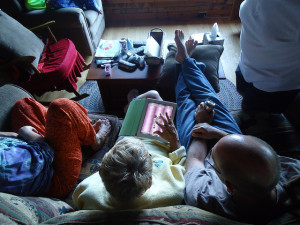For families in rural areas where the nearest hospital or care center is 30 miles away, the ability to video chat instantly with a healthcare provider over a broadband connection is more than a convenience – it could be a lifesaver.
That’s what KVC Health Systems plans to make happen.
The child welfare and behavioral healthcare agency has launched a new program that will equip 550 Kansas foster families, including all those in the Kansas City metro area, with iPads that will allow them increased access to KVC staff. It could be just to check in between in-person counseling sessions, or it could be during a crisis situation.
“This is not replacing any services. It’s an added layer,” said Michelle Lawrence, Vice President of Development for KVC.
Lawrence shared news of the grant-funded program at the June 2015 meeting of the KC Digital Drive Health Innovation Team. She explained that families in rural areas served by KVC in parts of Kansas, West Virginia, Kentucky and Nebraska, have needs that quick access to technology can meet efficiently and effectively.
“The population we serve has some pretty severe needs,” she said. “Many children in foster care have experienced trauma as a result of abuse or neglect, which may then affect their mental health or behavior. Some children may threaten to harm themselves or others.”
“We are on constant alert, wanting to be a resource to foster families that are giving them a home to help them heal,” Lawrence said.
At the end of June, KVC began distributing iPads equipped with MyLink, a service that allows foster children and parents to talk with KVC behavioral health care staff over a secure connection.
The program is among the first in the nation to apply telehealth to a foster care setting. It was tested first with 10 families in West Virginia and Kentucky and is currently being used in 161 foster homes. The initial pilot for Kansas includes 25 families in the Kansas City area. When the program is complete, it will serve more than 1,000 families in KVC’s national network.
“Therapists who were travelling a great deal to see one or two kids are now able to see four children in a day,” Lawrence said.
The program’s main obstacle is the lack of network access in some areas. According to Lawrence, 95 percent of KVC’s foster families in Kansas have high-speed Internet at home, but in rural Kentucky and West Virginia, getting a connection is more of a struggle.
Still, the program encompasses more than 3,200 children in Kansas and thousands more in other states, all of whom will be soon be getting face time with therapists and case workers – to practice new skills, to participate in ongoing foster parent education and in times of crisis.

